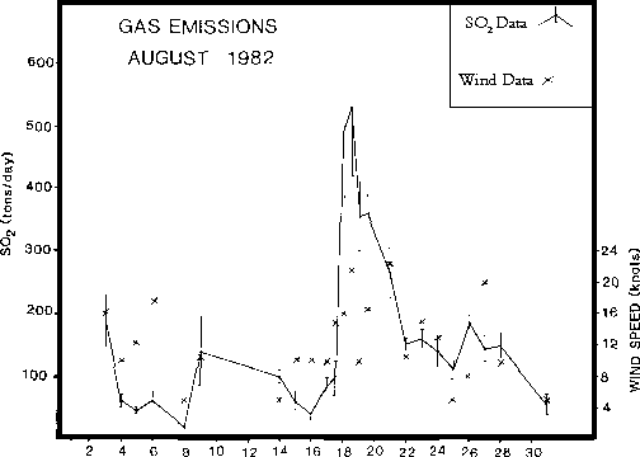Report on St. Helens (United States) — August 1982
Scientific Event Alert Network Bulletin, vol. 7, no. 8 (August 1982)
Managing Editor: Lindsay McClelland.
St. Helens (United States) New lobe extruded onto composite lava dome
Please cite this report as:
Global Volcanism Program, 1982. Report on St. Helens (United States) (McClelland, L., ed.). Scientific Event Alert Network Bulletin, 7:8. Smithsonian Institution. https://doi.org/10.5479/si.GVP.SEAN198208-321050
St. Helens
United States
46.2°N, 122.18°W; summit elev. 2549 m
All times are local (unless otherwise noted)
Lava extrusion that began early 18 August added a new lobe to the composite dome during the next 5 days. Seismicity and increasing deformation of the dome and the surrounding crater floor preceded the eruption, which included about a day of strong endogenous-dome growth before lava appeared at the surface.
Distances and vertical angles were measured between five sites on the crater floor and targets (5-6/station) on the dome. Rapid acceleration of dome deformation started about 6 August, but was strongly asymmetrical, concentrated on the W side. Some targets on the W side of the dome were moving outward at 30 cm/day by 15 August, but distances between the crater floor and points on the E and N sides of the dome shortened by no more than 4 and 5 cm/day respectively, and no movement occurred there until a week before the eruption.
The number of earthquakes that could be located by the University of Washington-USGS seismic net (usually events with magnitudes of 1 or greater) began to build in late July (SEAN 07:07), then increased to an average of 6/day 11-13 August and about 12/day 14-16 August. All were centered within a few kilometers of the surface. Smaller events (magnitude less than or equal to 0) showed comparatively steady increases through this period.
Continuously recording tiltmeters 50-60 m W of the dome measured thousands of µrad of tilting. A tilt reversal had been noted a few hours before the start of some earlier extrusion episodes, but no such reversal preceded the August eruption. Rapid tilting was recorded until rockfalls from the new lobe ended transmission.
Rapid thrusting began in mid-August along cracks in the crater floor W of the dome, reaching rates of 2.5 m/day laterally and 1.5 m/day vertically along the most vigorous fault just before the eruption. The thrusting subdivided the W crater floor into numerous small blocks, and one dry tilt station was cut by a 3 m thrust scarp. Tilt stations will be re-established but on a part of the crater floor less prone to thrusting. Rapid endogenous growth of the W side of the dome began 17 August. Parts of the W side of the dome moved 12 m outward that day and 22 m of displacement (13 m [downward]) of one W side dome target was measured the next day. The character of seismicity began a gradual change on 17 August, when only two events occurred that were large enough to be located, and surface (rockfall or gas emission) events started to dominate the seismic records.
New lava was first seen on the surface of the dome at 1130 on 18 August, emerging from the NW side of the summit. After the new lava appeared, the June 1981 and March 1982 lobes began to crack apart, and large blocks rolled down the W side of the dome. When geologists left the crater at about 1800, the new lobe was still small and was confined to the summit area.
By the next morning, lava had flowed onto the NW flank and was moving down the talus slope at the base of the dome. Substantial growth of the new lobe continued through the 19th, and slower extrusion occurred for the next few days before ending between 22 and 23 August. Slow deformation of the E side of the dome (where targets remained in place during lava extrusion) continued through 20 August, then stopped, and had not resumed as of early September.
SO2 emission remained at the background level of 80 (± 50) t/d through 17 August, but increased sharply, to about 500 t/d, when lava extrusion began early 18 August (figure 22). After reaching a maximum of 530 (± 100) t/d that afternoon, the rate of SO2 emission declined gradually to 150 t/d on the 22nd, then remained at roughly 130 t/d through the end of August.
Geological Summary. Prior to 1980, Mount St. Helens was a conical volcano sometimes known as the Fujisan of America. During the 1980 eruption the upper 400 m of the summit was removed by slope failure, leaving a 2 x 3.5 km breached crater now partially filled by a lava dome. There have been nine major eruptive periods beginning about 40-50,000 years ago, and it has been the most active volcano in the Cascade Range during the Holocene. Prior to 2,200 years ago, tephra, lava domes, and pyroclastic flows were erupted, forming the older edifice, but few lava flows extended beyond the base of the volcano. The modern edifice consists of basaltic as well as andesitic and dacitic products from summit and flank vents. Eruptions in the 19th century originated from the Goat Rocks area on the N flank, and were witnessed by early settlers.
Information Contacts: D. Dzurisin, C. Heliker, C. Newhall, R. Symonds, USGS CVO, Vancouver, WA; S. Malone, University of Washington.


